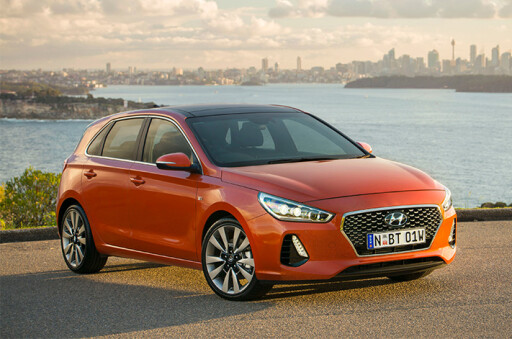
HYUNDAI has confirmed its i30 family will expand with a high-performance N-badged version of a yet-to-be-released fastback model.
Utilising a lower, sleeker shape that trades off interior space for an edgier look, the i30 fastback will be shown within months - and Hyundai’s European design chief Thomas Buerkle confirmed it will include an N hot hatch version.
“The car is still is still secret … it is a coupe-ish version of the i30 which will come also as an N and will furthermore show that we are bringing a whole family,” said Buerkle, who is in Australia for the launch of Hyundai’s top selling model.

Displaying a silhouette of the just-released i30 and the soon-to-arrive fastback, Buerkle confirmed the five-door coupe would have a lower roofline with a sleeker profile.
“It’s a very important segment … and the joy of driving and the joy of design should be in the foreground.”
As with the regular i30 N hot hatches, the i30 N fastback will get the choice of either a 184kW version of the 2.0-litre four-cylinder turbo or a 202kW version, the latter teamed with a stiffer, more aggressive chassis set-up aimed at the racetrack.
That latter version is also expected to get all-wheel drive, as well as a slick-shifting eight-speed dual-clutch transmission to give it a sub-five second 0-100km/h time.
Hyundai has already tested the i30 N in Australia, with a Wheels reader spotting the car north of Sydney earlier this year.
Expect more tuning and development work to take place between now and the anticipated late 2017 arrival.
At the other end of the scale, Hyundai is considering a new entry-level i30 to slot in below the Active, which is priced from $20,950.
Speaking at the launch of the i30, Hyundai Australia chief operating officer Scott Grant said the long list of equipment in the i30 Active opened the door to a more affordable model sometime during the life of the car.
“We think that in the spec that’s available to us in time … it may be possible for us to create a cheaper version at some point in time,” said Grant, adding that there was nothing planned yet.
The base i30 Active comes with alloy wheels, an 8.0-inch touchscreen, satellite navigation, Apple CarPlay and Android Auto connectivity, wireless Qi smartphone charging, a reversing camera, rear parking sensors and tyre pressure monitors.

About the only thing missing is active safety gear such as autonomous emergency braking (AEB), something that will be available as a circa-$1500 option on the Active late in the year (it will be standard on most other i30s).
While the headlines from Hyundai were about a $500 price reduction of the list price (before dealer and on-road costs), the reality is the i30 has gone up in price once drive-away pricing is applied. An Active with an auto transmission costs $24,990 on the road, some $5000 more than the $19,990 deals for the old i30 introduced at various times throughout 2016.
Grant said he believed that in a couple of years delivering an i30 closer to $20K might be a possibility by reverting to steel wheels and taking some of the high level of equipment out.
He also said some of the ground that the i30 used to play in could be covered by a new light car, such as the new generation Accent that’s due late this year or early in 2018.
As for discounting the current car to $19,990, Grant said it won’t happen.
“We’re playing a longer game now than we used to,” he said of a car planned to shift perceptions of the Hyundai brand, moving from cheap and cheerful to a more serious competitor to Toyota, Mazda and Volkswagen.
“Our strategy … is there’s a point in time … where you’ve got to bash and crash and burst through like a bull in a China shop in order to push product into the marketplace to be able to prove that you’ve got some scale and capability.
“Then there’s a time when you sort of need to do less of that and in a more mature sense reinvent yourself and go again in a different way.”
In some ways it’s similar to the strategy that Toyota used in the 1980s, whereby it built market share then went about building an aspirational reputation.

COMMENTS